DNN-Based Estimation of the Maximum Lateral Flange Moments of Horizontally Curved I-Girder Bridges
Abstract
:1. Introduction
2. Design Codes for Horizontally Curved I-Girder Bridge
2.1. Limitations of Warping Torsional Behavior and Cross-Frame Spacing
2.2. V-Load Method
3. Preparation of the Dataset for Horizontally Curved I-Girder Bridges
4. DNN Framework
4.1. Feature Selection through Least Absolute Shrinkage and Selection Operator (LASSO)
4.2. Proposed Neural Network Architecture
4.3. Behavior of a Horizontally Curved I-Girder Bridge According to Flange Width and Curvature
4.4. Performance Evaluation of the Proposed Model
5. Conclusions
- The stipulated equation demonstrated reasonable results as the curvature and flange width were reduced; however, it was confirmed that the error increased as the curvature and flange width increased. As the degree of curvature and flange width increased, the maximum lateral flange moment changed nonlinearly. However, the stipulated equation was not reflected. In particular, the flange width was not considered as a variable in the stipulated equation, and it was confirmed that the moment distribution varied according to the flange width. As the flange width increased, the lateral flange moment gradually increased, resulting in an increase in the maximum lateral flange moment values at the center of the span;
- LASSO was performed to select the major features of the design parameters. According to the results of LASSO, the geometric conditions and boundary conditions, such as the number of girders, number of cross-frames, unbraced length (), curvature (), and number of spans, significantly influenced the warping behavior. In the case of the cross-section, it was confirmed that the flange width and height had a significant influence. However, the flange thickness (), cross-frame area (), and web thickness () did not have a relatively larger effect compared with the other parameters within the design range, exhibiting a weight of zero;
- A DNN-based model was proposed to estimate the maximum lateral flange moment of a horizontally curved I-girder bridge. Six neural network architectures were constructed according to the number of hidden layers and neurons. The models were compared using three evaluation indices: MAE, RMSE, and R2. The L5 N100 model, which showed the highest performance in terms of MAE, RMSE, and R2 indicators, was proposed as the final estimation model considering general performance and accuracy;
- Verification was performed to determine whether the performance degradation problem caused by the parameter, which was a limitation of the proposed equation based on the V-load method, could be resolved using the proposed model. The performance evaluation confirmed that the distribution was very close to the y = x graph and exhibited high accuracy irrespective of the consideration of the parameters. Finally, it was confirmed that the performance degradation problem caused by the parameters can be solved using the proposed model.
Author Contributions
Funding
Data Availability Statement
Conflicts of Interest
References
- Davidson, J.S.; Keller, M.A.; Yoo, C.H. Cross-frame spacing and parametric effects in horizontally curved I-girder bridges. J. Struct. Eng. 1996, 122, 1089–1096. [Google Scholar] [CrossRef]
- AASHTO. Guide Specifications for Horizontally Curved Highway Bridges; American Association of State Highway Bridges: Washington, DC, USA, 1980. [Google Scholar]
- Steel, U.S. V-load analysis, an approximate procedure, simplified and extended for determining moments and shears in designing horizontally curved open framed highway bridges. USS Highw. Struct. Des. Handb. 1984, 1, 1–53. [Google Scholar]
- Hanshin. Guidelines for the Design of Horizontally Curved Girder Bridges; Hanshin Expressway Public Corporation: Osaka, Japan, 1988. [Google Scholar]
- Hoffman, J.J. Analytical and Field Investigation of Horizontally Curved Girder Bridges. Ph.D. Dissertation, Lowa State University, Ames, IA, USA, 2013. [Google Scholar]
- AASHTO. AASHTO LRFD Bridge Design Specifications, 7th ed.; American Association of State Highway and Transportation Officials: Washington, DC, USA, 2014. [Google Scholar]
- Oh, S.J.; Lim, C.O.; Park, B.C.; Lee, J.C.; Shin, S.C. Deep neural networks for maximum stress prediction in piping design. Int. J. Fuzz. Logic Intell. Syst. 2019, 19, 140–146. [Google Scholar] [CrossRef]
- Min, S.; Jeong, K.; Noh, Y.; Won, D.; Kim, S. Damage detection for tethers of submerged floating tunnels based on convolutional neural networks. Ocean Eng. 2022, 250, 111048. [Google Scholar] [CrossRef]
- Shu, J.; Zhang, Z.; Gonzalez, I.; Karoumi, R. The application of a damage detection method using Artificial Neural Network and train-induced vibrations on a simplified railway bridge model. Eng. Struct. 2013, 52, 408–421. [Google Scholar] [CrossRef] [Green Version]
- Zhou, Y.; Sun, L.; Peng, Z. Mechanisms of thermally induced deflection of a long-span cable-stayed bridge. Smart Struct. Syst. 2015, 15, 505–522. [Google Scholar] [CrossRef]
- Jeong, J.H.; Jo, H. Deep reinforcement learning for automated design of reinforced concrete structures. Comput.-Aided Civ. Infrastruct. Eng. 2021, 36, 1508–1529. [Google Scholar] [CrossRef]
- AASHTO. AASHTO LRFD Bridge Design Specifications, 9th ed.; American Association of State Highway and Transportation Officials: Washington, DC, USA, 2020. [Google Scholar]
- Barr, P.J.; Yanadori, N.; Halling, M.W.; Womack, K.C. Live-load analysis of a curved I-girder bridge. J. Bridge Eng. 2007, 12, 477–484. [Google Scholar] [CrossRef]
- SIMULIA. ABAQUS Manual; Dassault Systèmes Simulia Corp.: Johnston, RI, USA, 2022. [Google Scholar]
- Davidson, J.S.; Yoo, C.H. Local buckling of curved I-girder flanges. J. Struct. Eng. 1996, 122, 936–947. [Google Scholar] [CrossRef]
- KMCT. Design Manual for Highway Bridges; Ministry of Land, Infrastrucure and Transportation: Sejong, Republic of Korea, 2008.
- Lee, S.; Lee, K.; Lee, J. Damage detection in truss structures using deep learning techniques. J. Korean Associat. Spatial Struct. 2019, 19, 93–100. [Google Scholar] [CrossRef]
- Yang, Z.; Yu, C.H.; Buehler, M.J. Deep learning model to predict complex stress and strain fields in hierarchical composites. Sci. Adv. 2021, 7, eabd7416. [Google Scholar] [CrossRef] [PubMed]
- Wang, T.; Altabey, W.A.; Noori, M.; Ghiasi, R. A deep learning based approach for response prediction of beam-like structures. Struct. Durab. Health Monit. 2020, 14, 315. [Google Scholar] [CrossRef]
- Liang, L.; Liu, M.; Martin, C.; Sun, W. A deep learning approach to estimate stress distribution: A fast and accurate surrogate of finite-element analysis. J. R. Soc. Interface 2018, 15, 20170844. [Google Scholar] [CrossRef] [PubMed]
- Ramaswami, M.; Bhaskaran, R. A study on feature selection techniques in educational data mining. arXiv 2009, arXiv:0912.3924. [Google Scholar]
- Muthukrishnan, R.; Rohini, R. LASSO: A feature selection technique in predictive modeling for machine learning. In Proceedings of the 2016 IEEE International Conference on Advances in Computer Applications (ICACA), Coimbatore, India, 24–24 October 2016. [Google Scholar]
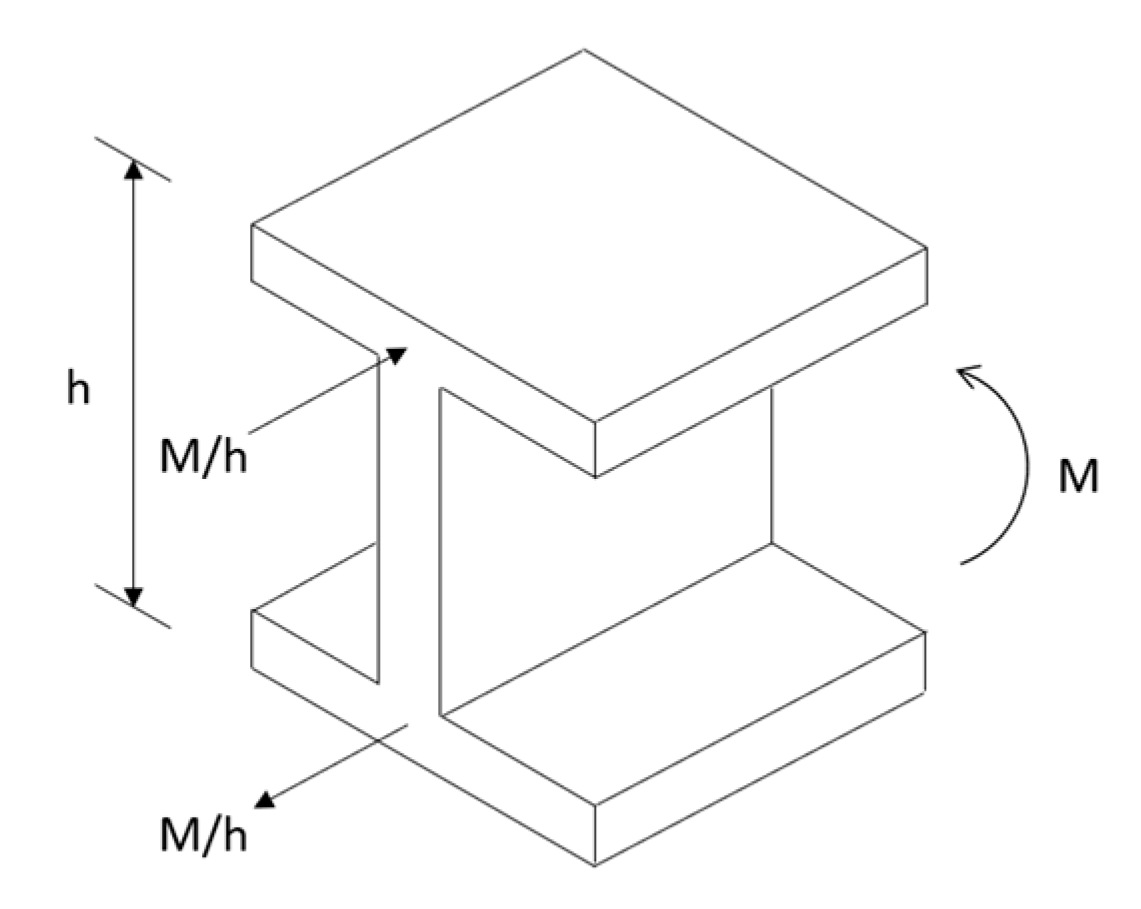


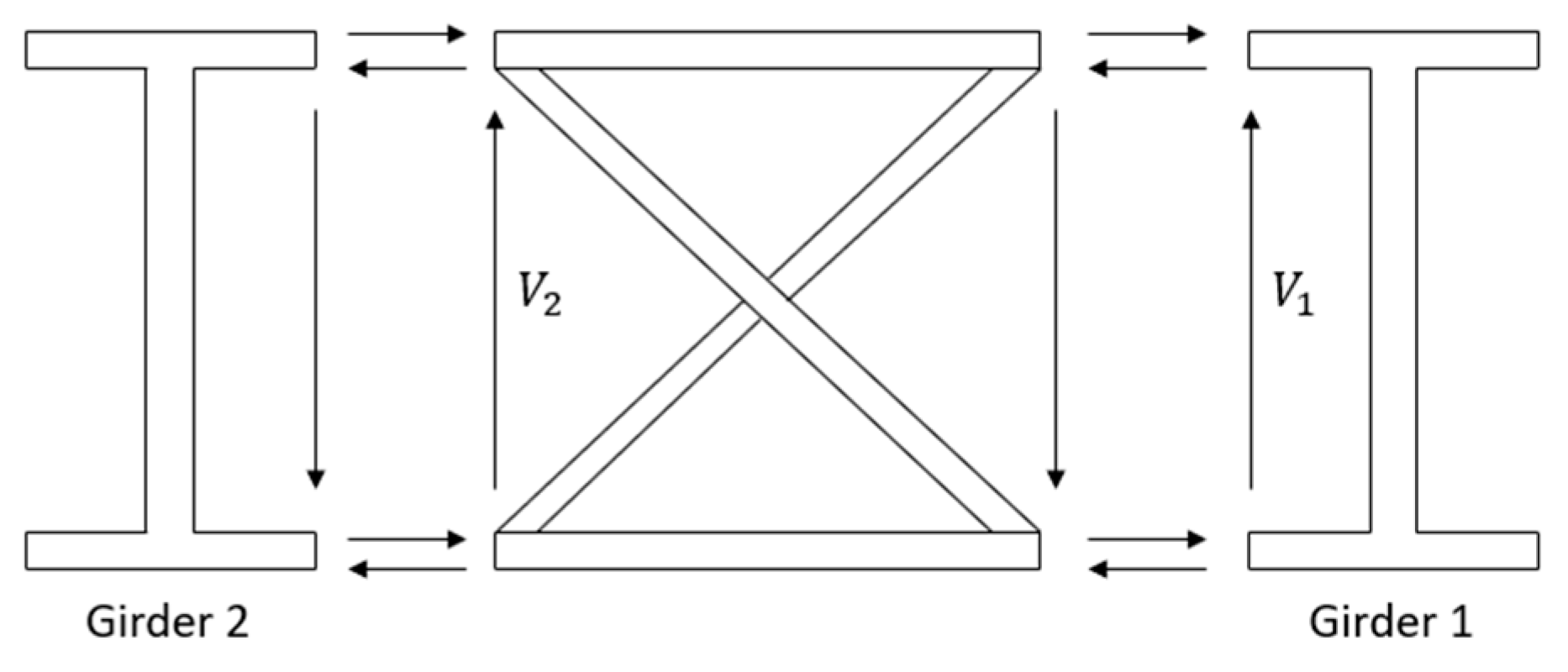

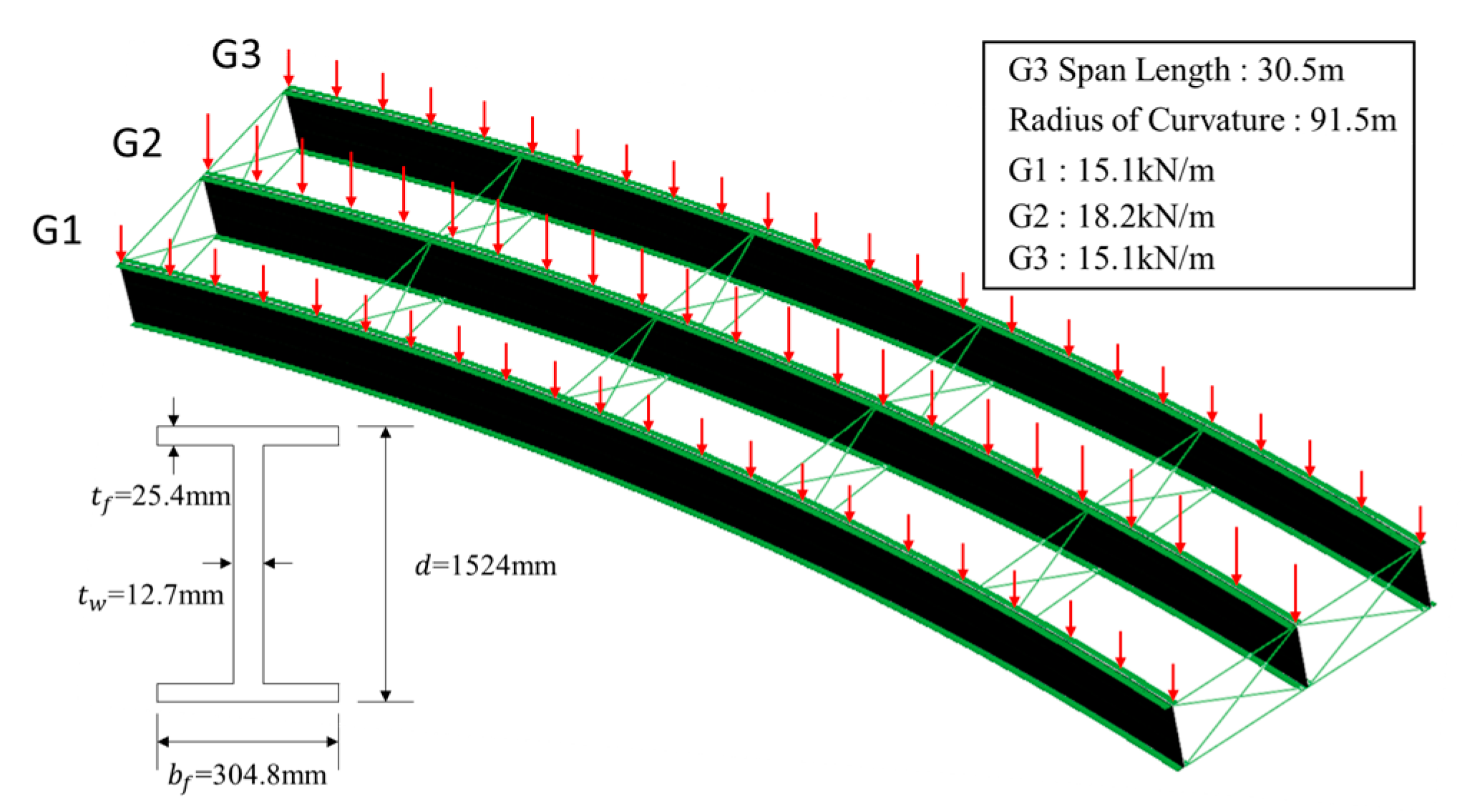
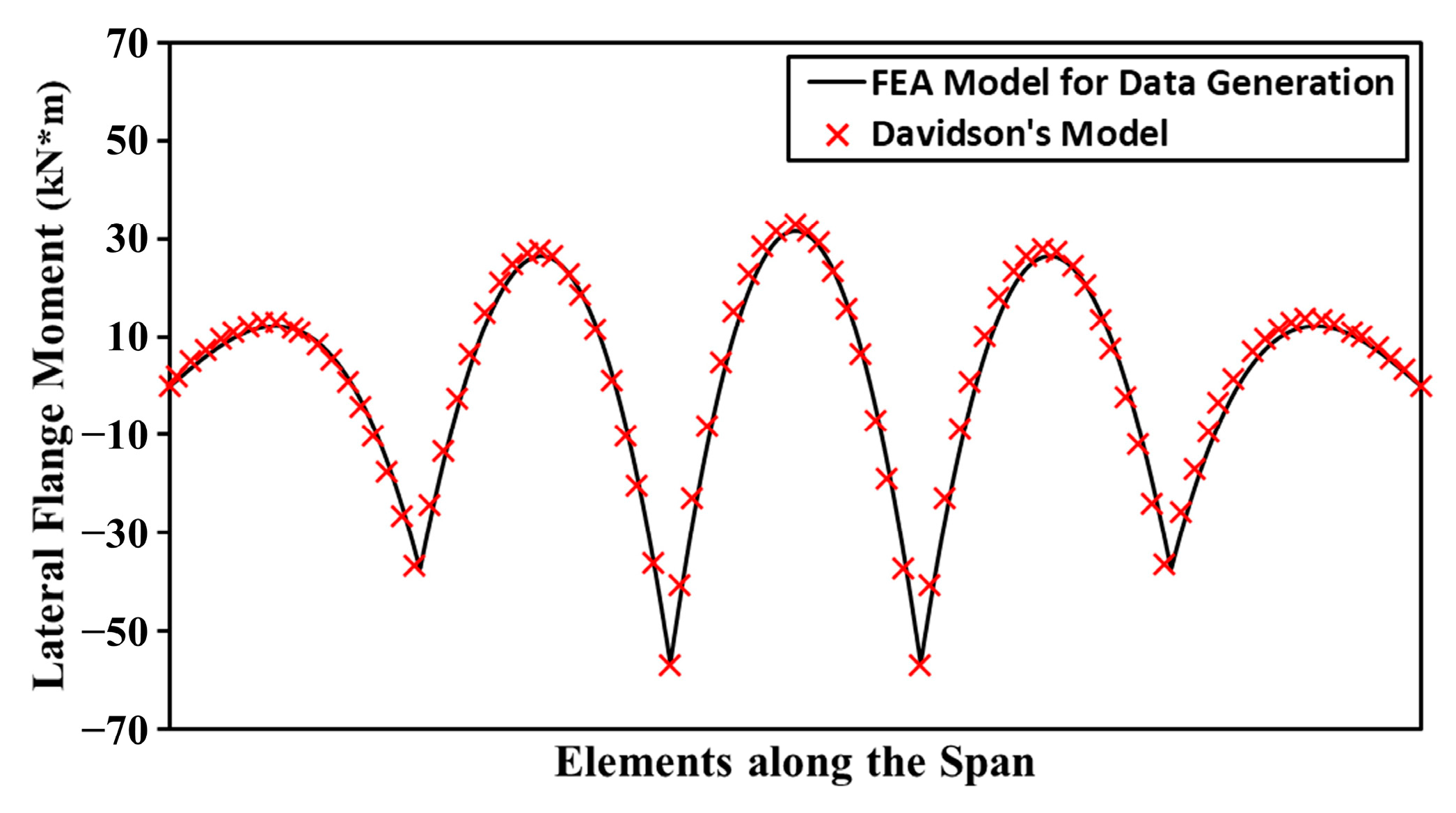
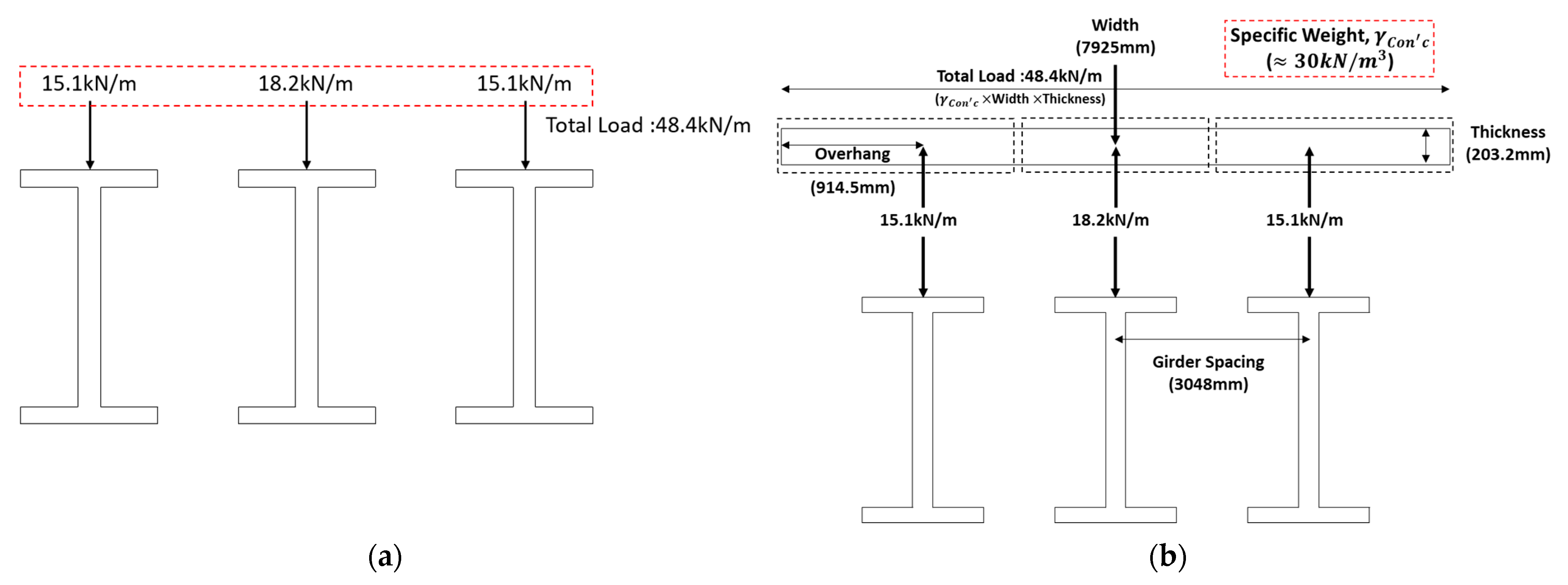
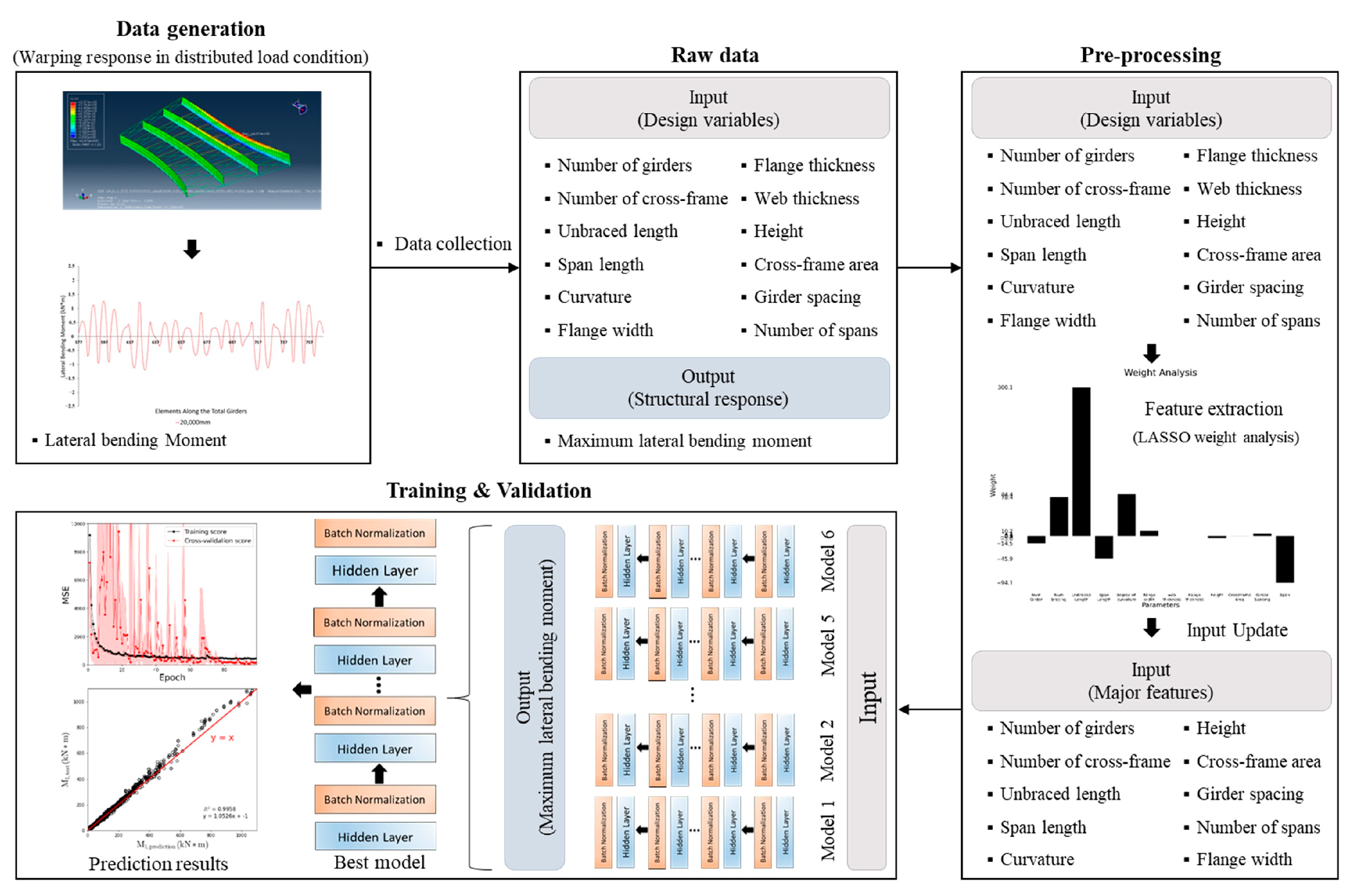

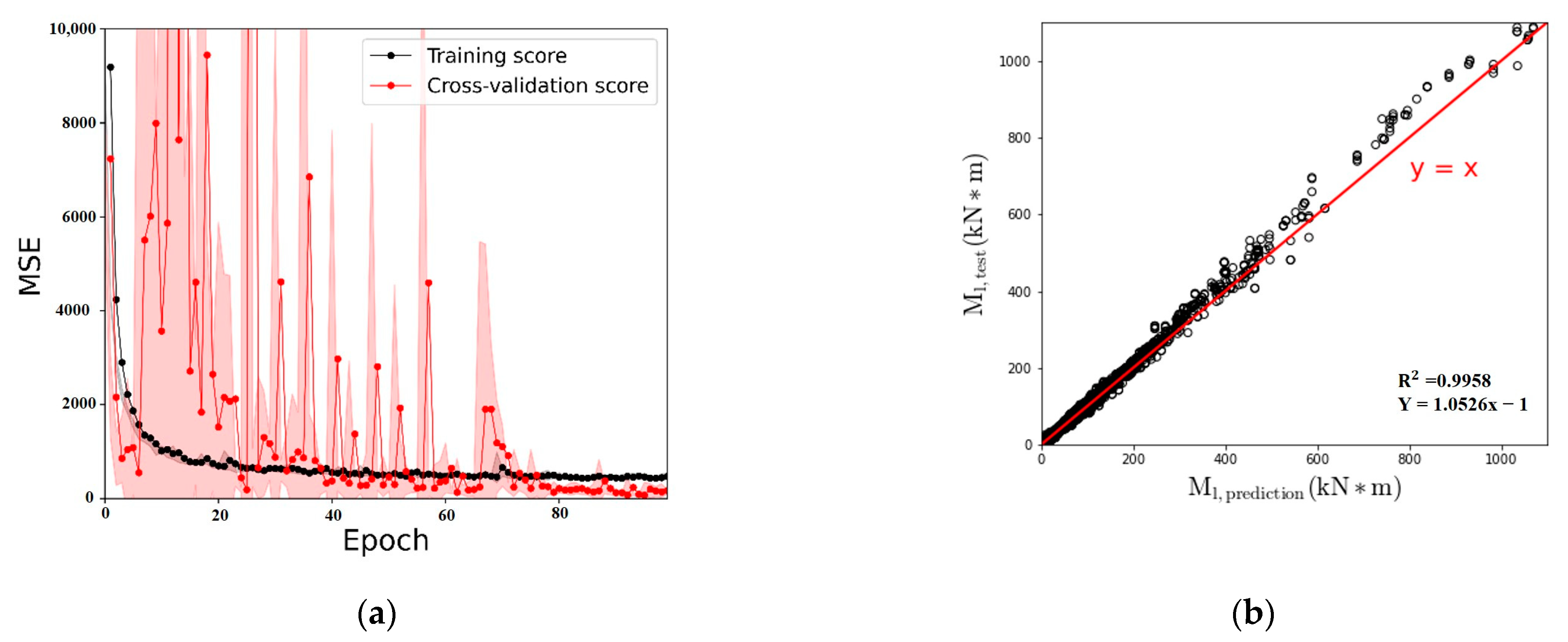
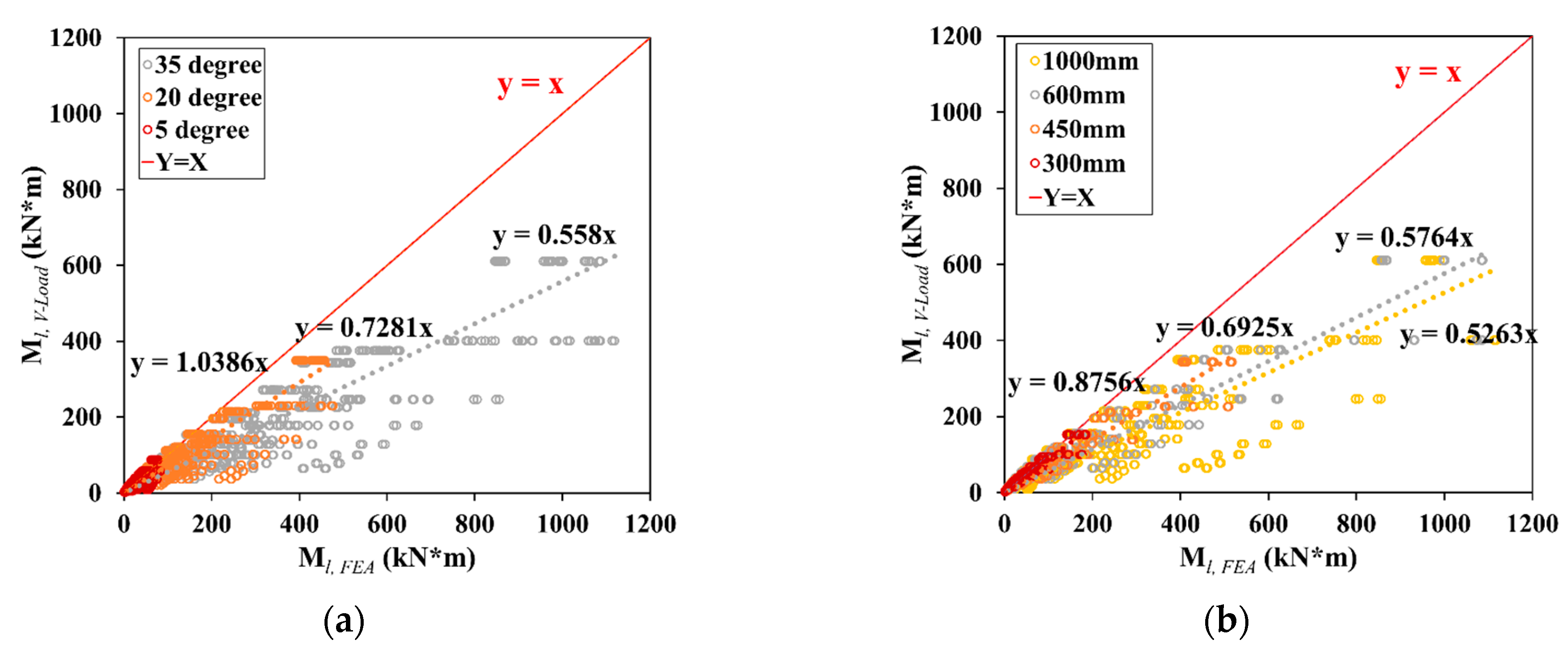
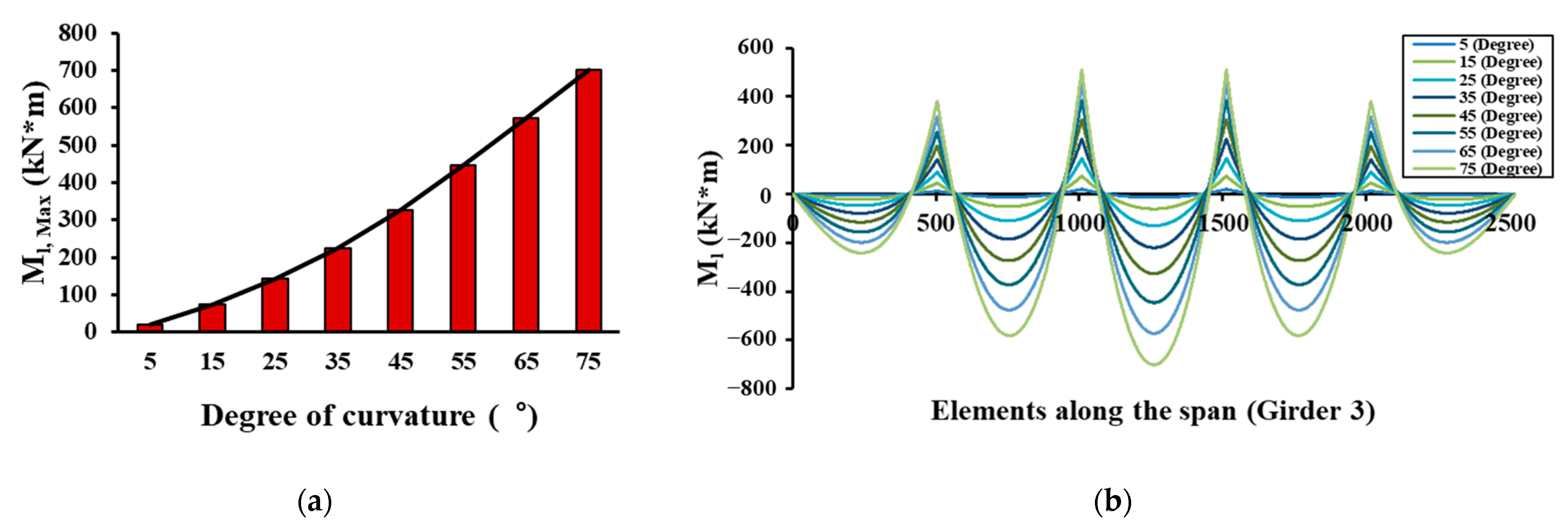

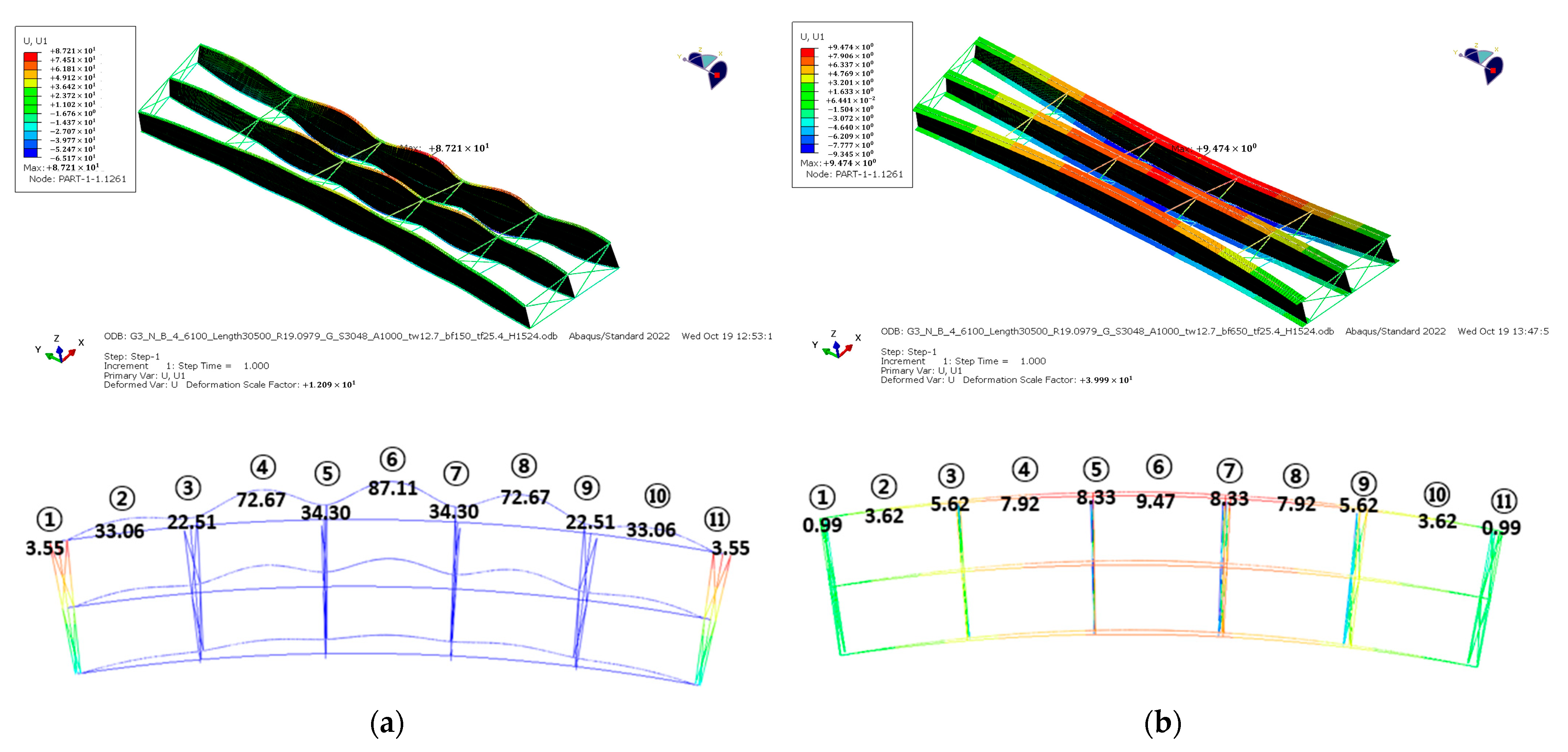
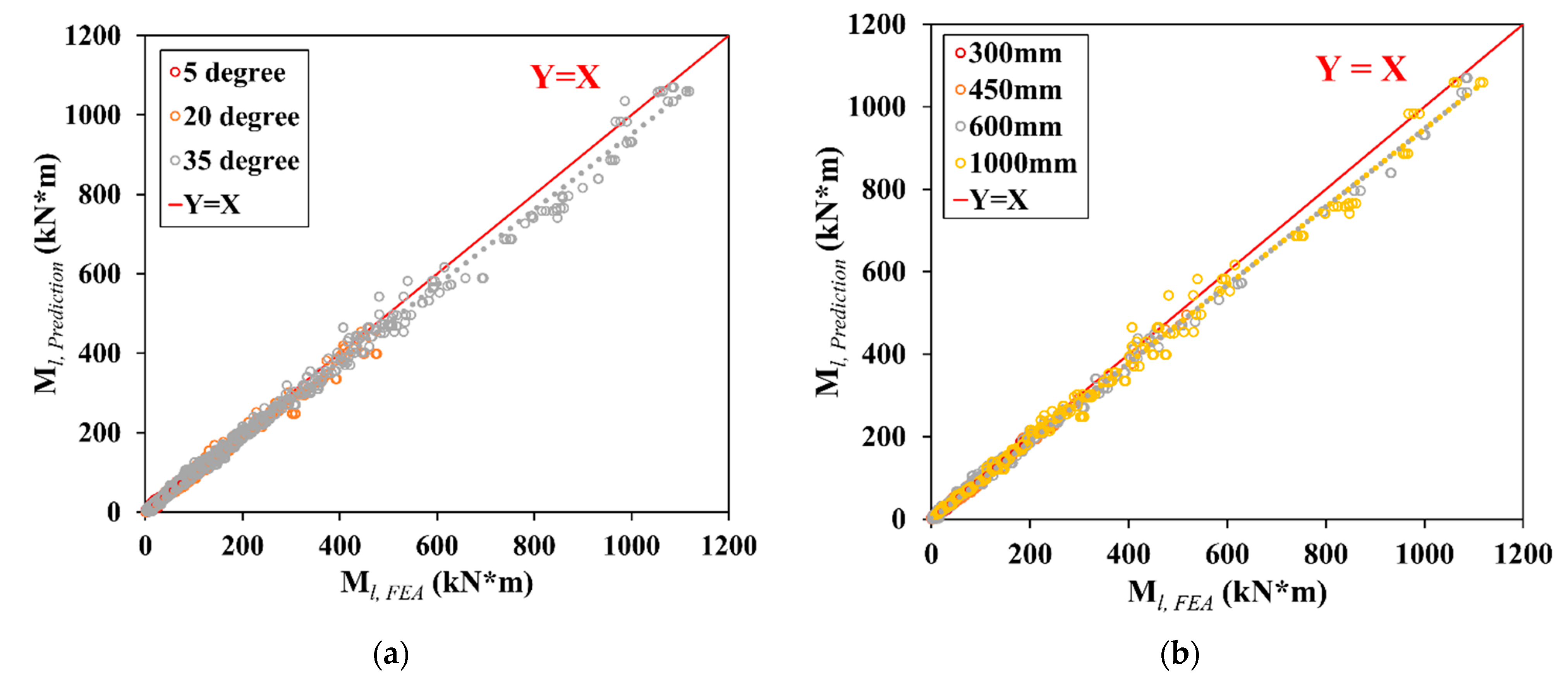

| Parameter | Min | Max | EA |
|---|---|---|---|
| No. of Cross-frame | 3 | 9 | 7 |
| No. of Girder | 2 | 4 | 3 |
| Cross-frame Area () | 1000 | 10,000 | 3 |
| Span Length () | 30,000 | 60,000 | 3 |
| Girder Spacing () | 2000 | 4000 | 2 |
| Number of Spans (EA) | 1 | 3 | 3 |
| Height and Width Ratio (H/) | 3 | 5 | 3 |
| Height and Length Ratio (H/L) | 1/20 | 1 | |
| Degree of Curvature (°) | 5 | 35 | 3 |
| Flange Thickness () | 10 | 40 | 2 |
| Web Thickness () | 10 | 15 | 2 |
| Total FEA data set | 40,824 | ||
| Parameter | Value |
|---|---|
| Batch size | 32 |
| Learning rate | 0.001 |
| Number of neurons at the output layer | 1 |
| Activation function | ReLU |
| Loss function | MSE |
| Optimizer | Adam |
| Epoch | 100 |
| Parameter | Number of Girders | Number of Cross-Frames | θ | |||
|---|---|---|---|---|---|---|
| Weight | −14.497 | 78.375 | 300.136 | −45.943 | 84.379 | 10.175 |
| Parameter | Number of Spans | |||||
| Weight | 0.230 | 0 | −5.041 | −0.388 | 4.216 | −94.079 |
| Model | Dataset | R2 | RMSE | MAE | ||||||||||||
|---|---|---|---|---|---|---|---|---|---|---|---|---|---|---|---|---|
| K = 1 | K = 2 | K = 3 | K = 4 | K = 5 | K = 1 | K = 2 | K = 3 | K = 4 | K = 5 | K = 1 | K = 2 | K = 3 | K = 4 | K = 5 | ||
| (1) | Test | 0.96 | 0.96 | 0.96 | 0.96 | 0.96 | 20.7 | 22.2 | 20.3 | 22.3 | 20.0 | 9.24 | 13.3 | 11.0 | 10.4 | 12.2 |
| Average | 0.96 | 21.1 | 11.228 | |||||||||||||
| (2) | Test | 0.97 | 0.97 | 0.97 | 0.97 | 0.97 | 18.9 | 19.7 | 18.6 | 19.0 | 18.1 | 10.2 | 12.1 | 10.6 | 9.97 | 9.95 |
| Average | 0.97 | 18.86 | 10.564 | |||||||||||||
| Model | Dataset | R2 | RMSE | MAE | ||||||||||||
|---|---|---|---|---|---|---|---|---|---|---|---|---|---|---|---|---|
| K = 1 | K = 2 | K = 3 | K = 4 | K = 5 | K = 1 | K = 2 | K = 3 | K = 4 | K = 5 | K = 1 | K = 2 | K = 3 | K = 4 | K = 5 | ||
| L1 N50 | Test | 0.97 | 0.97 | 0.97 | 0.97 | 0.97 | 18.9 | 19.7 | 18.6 | 19.0 | 18.1 | 10.2 | 12.1 | 10.6 | 9.97 | 9.95 |
| Average | 0.97 | 18.86 | 10.564 | |||||||||||||
| L5 N50 | Test | 0.99 | 1.0 | 0.99 | 0.98 | 0.99 | 13.1 | 7.67 | 8.82 | 13.9 | 8.87 | 7.60 | 4.94 | 5.20 | 5.57 | 4.38 |
| Average | 0.99 | 10.472 | 5.538 | |||||||||||||
| L8 N50 | Test | 0.98 | 0.99 | 0.99 | 0.99 | 0.98 | 16.6 | 12.7 | 10.3 | 8.75 | 16.09 | 8.92 | 6.60 | 4.37 | 5.41 | 7.72 |
| Average | 0.986 | 12.888 | 6.604 | |||||||||||||
| L1 N100 | Test | 0.97 | 0.97 | 0.97 | 0.98 | 0.97 | 17.5 | 19.6 | 19.7 | 19.7 | 16.56 | 9.33 | 8.48 | 9.47 | 13.4 | 9.20 |
| Average | 0.972 | 18.612 | 9.976 | |||||||||||||
| L5 N100 | Test | 1.00 | 1.00 | 1.00 | 1.00 | 1.00 | 8.50 | 6.56 | 7.31 | 7.72 | 8.68 | 3.75 | 3.96 | 3.80 | 4.20 | 3.99 |
| Average | 1.00 | 7.754 | 3.94 | |||||||||||||
| L8 N100 | Test | 0.99 | 0.99 | 0.99 | 0.99 | 0.99 | 8.65 | 9.49 | 7.77 | 9.97 | 9.08 | 5.43 | 6.95 | 4.28 | 4.42 | 4.46 |
| Average | 0.99 | 8.992 | 5.108 | |||||||||||||
Disclaimer/Publisher’s Note: The statements, opinions and data contained in all publications are solely those of the individual author(s) and contributor(s) and not of MDPI and/or the editor(s). MDPI and/or the editor(s) disclaim responsibility for any injury to people or property resulting from any ideas, methods, instructions or products referred to in the content. |
© 2023 by the authors. Licensee MDPI, Basel, Switzerland. This article is an open access article distributed under the terms and conditions of the Creative Commons Attribution (CC BY) license (https://creativecommons.org/licenses/by/4.0/).
Share and Cite
Ryu, S.; Lee, J.; Kang, Y.J. DNN-Based Estimation of the Maximum Lateral Flange Moments of Horizontally Curved I-Girder Bridges. Buildings 2023, 13, 317. https://doi.org/10.3390/buildings13020317
Ryu S, Lee J, Kang YJ. DNN-Based Estimation of the Maximum Lateral Flange Moments of Horizontally Curved I-Girder Bridges. Buildings. 2023; 13(2):317. https://doi.org/10.3390/buildings13020317
Chicago/Turabian StyleRyu, Seongbin, Jeonghwa Lee, and Young Jong Kang. 2023. "DNN-Based Estimation of the Maximum Lateral Flange Moments of Horizontally Curved I-Girder Bridges" Buildings 13, no. 2: 317. https://doi.org/10.3390/buildings13020317






